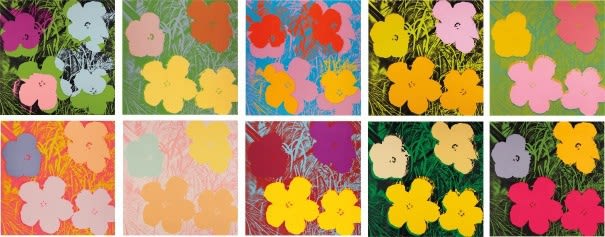
In 1970, Andy Warhol created a series of screen prints featuring flowers as the principal subject. The series was a departure from his earlier work, which had focused on everyday objects and commercial products, and marked a shift in his artistic style. Typified by his obsession with the quotidian, Warhol would usually draw inspiration from the notion of celebrity, public figures and commercial products.Numbered a series of 10 different works, each signed, numbered and dated from an edition of 250 the series has become highly sought-after by collectors across the globe.
Much like his previous artworks, Warhol created the Flower prints using a process known as screen printing which he furthered as a medium and popularised like never before. Prior to Warhol’s artistic use of screenprinting the technique was primarily used for commercial printing activities. Warhol built different layers and depths to his works through using different screens for each colour, allowing him to create complex and layered compositions.
The Flower series was initially inspired by a photograph of hibiscus flowers that Warhol found in a magazine. An avid devotee to consumer culture, it is interesting to see Warhol’s ability to extract beauty from the seemingly mundane and sources that one would not generally find inspiration from. Warhol was instantly drawn to the vibrant colours and the graphic quality of the image, and decided to use it as the basis for a new series of prints.
The series, published in 1970, evokes the Flower Power movement of the 1960s, Warhol's Flowers have also been interpreted as a symbol of mourning, as the artist created these works just after President John F. Kennedy's assassination. A time of great upheaval and introspection in American culture in an event that shook the world breaking from the promise of youth that Kennedy represented for many.
The resulting prints featured bold, colourful flowers set against various backgrounds. There is a sense of juxtaposition in the works with minimalist detailing in the flowers - varying in each of the 10 works - against the more photorealistic background of stems and grass.
Fleeting and pure, the dazzling series bursts with energy, vibrancy and colour. The blossoms evoke ideas of growth yet serve as a tender reminder of the transient and fleeting nature of beauty. The four flowers stand alone, frozen in time.
Flowers served up a rainbow spectrum of technicolor possibilities; Warhol's budding blossoms evoked self-improvement, that most American enterprise. The hypnotic repetition of this flowery image that was clipped from a magazine mimicked the obsessive nature of a postwar public—inundated with images of opulence both on television as well as in printed ads—that was fixated like never before on beauty.
The Flower prints were an instant success, and helped to establish Warhol as one of the most important artists of his generation. They were widely praised for their bold, graphic style and their ability to capture the essence of everyday objects in a new and exciting way.
Despite their initial success, the Flower prints were not without controversy. Some critics saw them as a departure from Warhol's earlier work, which had been focused on the commercial products of American culture. Others saw them as a commentary on the superficiality of consumer culture, or as a critique of the art world itself.
Regardless of the interpretation, the Flower prints remain an important part of Warhol's legacy. They represent a key moment in the development of his artistic style, and serve as a testament to his ability to find beauty in unexpected places. Vulnerable and fleeting, the works have gained a resurgence in recent years both with typical Warhol collectors and wider pop-art collectors.
Discover our selection of Andy Warhol screen prints for sale or contact Andipa Editions via sales@andipa.com or call +44 (0)20 7589 2371 for further information on our selection to buy original Andy Warhol screenprints.